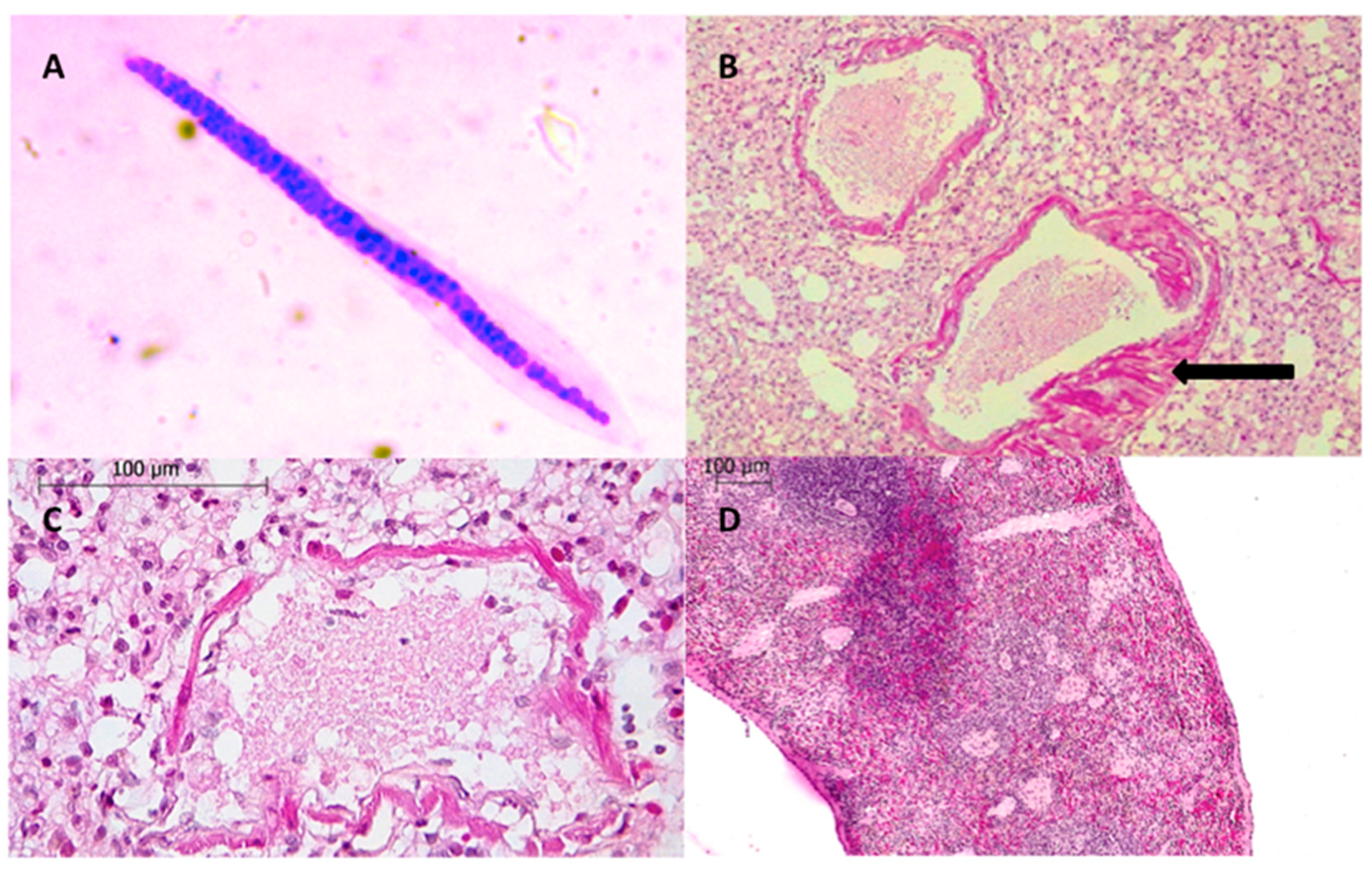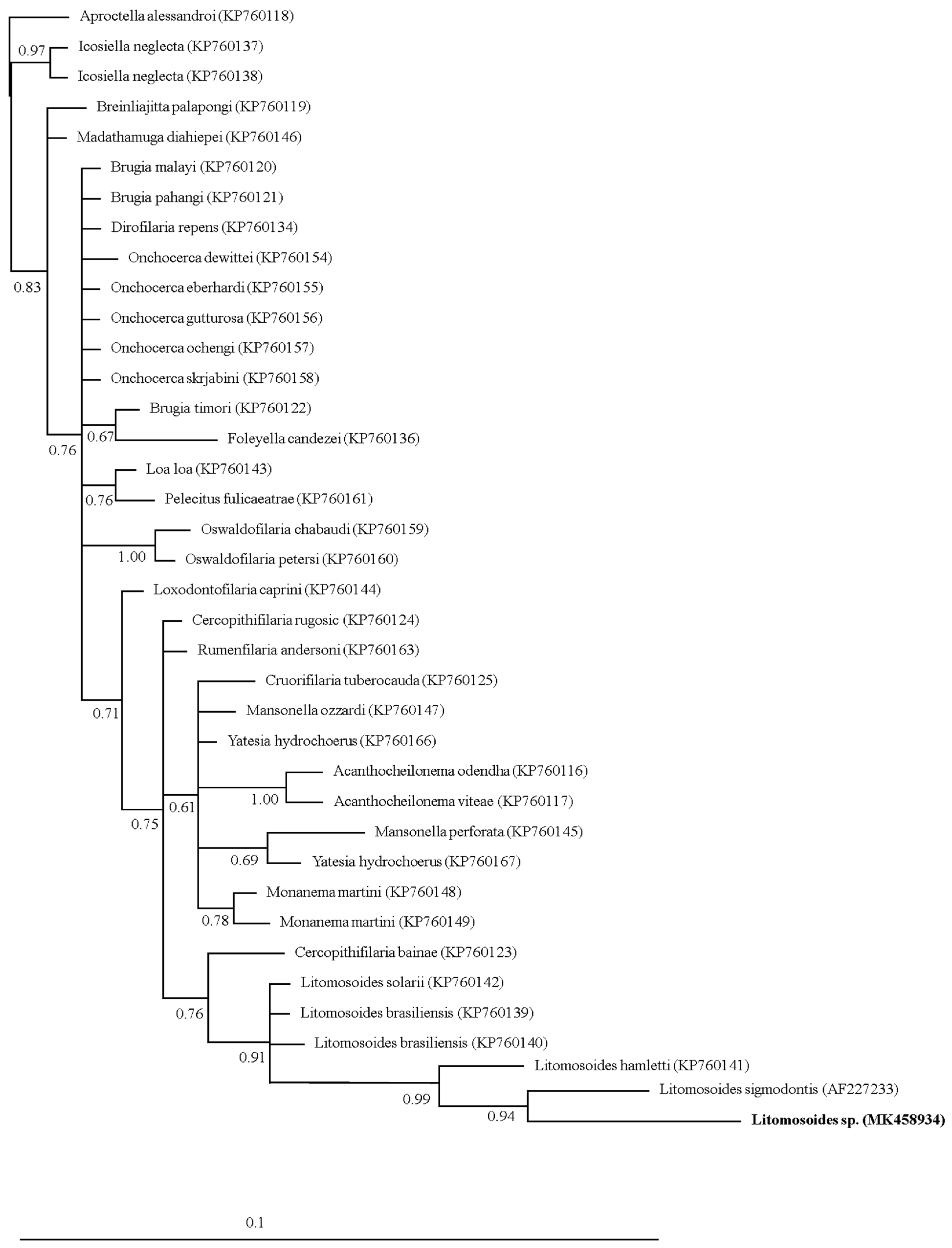Litomosoides sp. (Filarioidea: Onchocercidae) Infection in Frugivorous Bats (Artibeus spp.): Pathological Features, Molecular Evidence, and Prevalence
Abstract
1. Introduction
2. Materials and Methods
2.1. Study Area and Animals Capture
2.2. Collection of Biological Material
2.3. Microfilaria Identification and Parasite Load Calculation
2.4. Molecular DNA Analysis
2.5. Prevalence Analysis
2.6. Histopathological Analysis
3. Results
3.1. Filariae Identification
3.2. Parasite Load
3.3. Histopathology
4. Discussion
Author Contributions
Funding
Acknowledgments
Conflicts of Interest
References
- Mandl, J.N.; Schneider, C.; Schneider, D.S.; Baker, M.L. Going to bat(s) for studies of disease tolerance. Front. Immunol. 2018, 9, 2112. [Google Scholar] [CrossRef]
- Frick, W.F.; Puechmaille, S.J.; Willis, C.K. White-nose syndrome in bats. In Bats in the Anthropocene: Conservation of Bats in a Changing World; Voigt, C.C., Kingston, T., Eds.; Springer: Cham, Switzerland; New York, NY, USA, 2016; pp. 245–262. [Google Scholar]
- Badrane, H.; Tordo, N. Host switching in Lyssavirus history from the Chiroptera to the Carnivora orders. J. Virol. 2001, 75, 8096–8104. [Google Scholar] [CrossRef] [PubMed]
- Brook, C.E.; Dobson, A.P. Bats as ‘special’reservoirs for emerging zoonotic pathogens. Trends Microbiol. 2015, 23, 172–180. [Google Scholar] [CrossRef] [PubMed]
- Jiménez, F.A.; Caspeta-Mandujano, J.M.; Ramírez-Chávez, S.B.; Ramírez-Díaz, S.E.; Juárez-Urbina, M.G.; Peralta-Rodríguez, J.L.; Guerrero, J.A. Checklist of helminths of bats from México and Central América. J. Parasite Biol. 2017, 7. [Google Scholar] [CrossRef]
- Muñoz-García, C.I.; López-Díaz, O.; Osorio-Sarabia, D.; Martínez-Hernández, F.; Villalobos, G.; Isaak-Delgado, A.B.; Pleite, C.M.C. New insights into the clinico-histopathological and molecular features of Pelecitus (Filarioidea: Onchocercidae) from a raptor bird. Parasitol. Res. 2018, 117, 3319–3325. [Google Scholar] [CrossRef] [PubMed]
- Guerrero, R.; Martin, C.; Gardner, S.L.; Bain, O. New and known species of Litomosoides (Nematoda: Filarioidea): Important adult and larval characters and taxonomic changes. Comp. Parasitol. 2002, 69, 177–195. [Google Scholar] [CrossRef]
- Marshall, L.G. A model for paleobiogeography of South American cricetine rodents. Paleobiology 1979, 5, 126–132. [Google Scholar] [CrossRef]
- Bain, O.; Philipp, M. Modèles animaux utiles pour l’étude des phénomènes parasitaires: Filaires et autres parasites. Ann. Parasitol. Hum. Comp. 1991, 66, 64–68. [Google Scholar] [PubMed]
- Brant, S.V.; Gardner, S.L. Phylogeny of species of the genus Litomosoides (Nemata [corrected]: Onchocercidae): Evidence of rampant host switching. J. Parasitol. 2000, 86, 545–554. [Google Scholar] [CrossRef]
- Hoffmann, W.; Petit, G.; Schulz-Key, H.; Taylor, D.; Bain, O.; Le Goff, L. Litomosoides sigmodontis in mice: Reappraisal of an old model for filarial research. Parasitol. Today 2000, 16, 387–389. [Google Scholar] [CrossRef]
- Moro, C.V.; Chauve, C.; Zenner, L. Vectorial role of some dermanyssoid mites (Acari, Mesostigmata, Dermanyssoidea). Parasite 2005, 12, 99–109. [Google Scholar] [CrossRef]
- Marchán-Rivadeneira, M.R.; Phillips, C.J.; Strauss, R.E.; Guerrero, J.A.; Mancina, C.A.; Baker, R.J. Cranial differentiation of fruit-eating bats (genus Artibeus) based on size-standardized data. Acta Chiropterol. 2010, 12, 143–154. [Google Scholar] [CrossRef]
- Medellín, R.A.; Arita, H.T.; Sanchez, H. Identificación de los Murciélagos de México. Clave de Campo, 2nd ed; Instituto de Ecología, Universidad Nacional Autónoma de México: México City, Mexico, 2008. [Google Scholar]
- Esslinger, J.H. The genus Litomosoides Chandler, 1931 (Filarioidea: Onchocercidae) in colombian bats and rats. J. Parasitol. 1973, 59, 225–246. [Google Scholar] [CrossRef]
- Anderson, R.C.; Bain, O. Diplotriaenoidea, Aproctoidea and Filarioidea. In C.I.H. Keys to the Nematode Parasites of Vertebrates; Anderson, R.C., Chabaud, A.G., Willmott, S.M., Eds.; Commonwealth Institute of Helminthology: St. Albans (Herts.), UK, 1976; pp. 59–116. [Google Scholar]
- Chabaud, A.G.; Bain, O. La lignée Dipetalonema. Nouvel essai de classification. Ann Parasitol. Hum. Comp. 1976, 51, 365–397. [Google Scholar] [CrossRef]
- Sambrook, J.; Fitsch, E.F.; Maniatis, T. Molecular Cloning: A Laboratory Manual, 3rd ed.; Cold Spring Harbor Laboratory Press: New York, NY, USA, 2001. [Google Scholar]
- Posada, D.; Crandall, K.A. Modeltest: Testing the model of DNA substitution. Bioinformatics 1998, 14, 817–818. [Google Scholar] [CrossRef]
- Holder, M.; Lewis, P.O. Phylogeny estimation: Traditional and Bayesian approaches. Nat. Rev. Genet. 2003, 4, 275–284. [Google Scholar] [CrossRef]
- Bouchery, T.; Ehrhardt, K.; Lefoulon, E.; Hoffmann, W.; Bain, O.; Martin, C. Differential tissular distribution of Litomosoides sigmodontis microfilariae between microfilaremic and amicrofilaremic mice following experimental infection. Parasite 2012, 19, 351. [Google Scholar] [CrossRef][Green Version]
- Wharton, D.R.A. Pathological changes in natural and experimental filariasis in the cotton rat. J. Infect. Dis. 1947, 80, 307–318. [Google Scholar] [CrossRef]
- Mohan, R.N. Pathological changes in white rats infected with Litomosoides carinii. Trans. R. Soc. Trop. Med. Hyg. 1973, 67, 883–884. [Google Scholar] [CrossRef]
- Zahner, H.; Rudolph, R.; Nolte, I. Histopathological and electron microscopical studies in Litomosoides carinii infected Mastomys natalensis. J. Vet. Med. B 1987, 34, 51–66. [Google Scholar] [CrossRef]
- Castleman, W.L.; Wong, M.M. Light and electron microscopic pulmonary lesions associated with retained microfilariae in canine occult dirofilariasis. Vet. Pathol. 1982, 19, 355–364. [Google Scholar] [CrossRef]
- Tarish, J.H.; Atwell, R.B. The role of Dirofilaria Immitis antigen in the pathogenesis of pulmonary arteritis in the dog. 1. The effects of antigen infusion. J. Vet. Med. B 1989, 36, 771–777. [Google Scholar] [CrossRef]
- Ninomiya, H.; Wakao, Y. Scanning electron microscopy of vascular corrosion casts and histologic examination of pulmonary microvasculature in dogs with dirofilariosis. Am. J. Vet. Res. 2002, 63, 1538–1544. [Google Scholar] [CrossRef]
- Taylor, M.D.; Van der Werf, N.; Harris, A.; Graham, A.L.; Bain, O.; Allen, J.E.; Maizels, R.M. Early recruitment of natural CD4+ Foxp3+ Treg cells by infective larvae determines the outcome of filarial infection. Eur. J. Immunol. 2009, 39, 192–206. [Google Scholar] [CrossRef]
- Cottontail, V.M.; Wellinghausen, N.; Kalko, E.K.V. Habitat fragmentation and haemoparasites in the common fruit bat, Artibeus jamaicensis (Phyllostomidae) in a tropical lowland forest in Panamá. Parasitology 2009, 136, 1133–1145. [Google Scholar] [CrossRef]
- Gutierrez-Pena, E.J.; Knab, J.; Buttner, D.W. Neutrophil granule proteins: Evidence for the participation in the host reaction to skin microfilariae of Onchocerca volvulus after diethylcarbamazine administration. Parasitology 1996, 113, 403–414. [Google Scholar] [CrossRef]
- Gillette-Ferguson, I.; Hise, A.G.; McGarry, H.F.; Turner, J.; Esposito, A.; Sun, Y.; Diaconu, E.; Taylor, M.J.; Pearlman, E. Wolbachia-induced neutrophil activation in a mouse model of ocular onchocerciasis (river blindness). Infect. Immun. 2004, 72, 5687–5692. [Google Scholar] [CrossRef]
- Medellin, R.A.; Gaona, O. Seed Dispersal by Bats and Birds in Forest and Disturbed Habitats of Chiapas, Mexico 1. Biotropica 1999, 31, 478–485. [Google Scholar] [CrossRef]



| Host Species | Prevalence % (Positive Bats/Total Bats) | Number of Microfilariae Tested | Body Length (µm), Mean ± SD | Body Width at the Nerve Ring (µm), Mean ± SD |
|---|---|---|---|---|
| Artibeus aztecus | 20 (2/10) | 8 | 74.9 (2.9) | 3.3 (0.4) |
| Artibeus jamaicensis | 4.2 (1/24) | 4 | 77.6 (6.2) | 4.3 (0.5) |
| Artibeus lituratus | 7.7 (1/13) | 4 | 78.8 (4.8) | 4.8 (2.5) |
© 2019 by the authors. Licensee MDPI, Basel, Switzerland. This article is an open access article distributed under the terms and conditions of the Creative Commons Attribution (CC BY) license (http://creativecommons.org/licenses/by/4.0/).
Share and Cite
Rendón-Franco, E.; López-Díaz, O.; Martínez-Hernández, F.; Villalobos, G.; Muñoz-García, C.I.; Aréchiga-Ceballos, N.; Alfonso-Toledo, J.A.; García Flores, M.M.; Aguilar Setién, A. Litomosoides sp. (Filarioidea: Onchocercidae) Infection in Frugivorous Bats (Artibeus spp.): Pathological Features, Molecular Evidence, and Prevalence. Trop. Med. Infect. Dis. 2019, 4, 77. https://doi.org/10.3390/tropicalmed4020077
Rendón-Franco E, López-Díaz O, Martínez-Hernández F, Villalobos G, Muñoz-García CI, Aréchiga-Ceballos N, Alfonso-Toledo JA, García Flores MM, Aguilar Setién A. Litomosoides sp. (Filarioidea: Onchocercidae) Infection in Frugivorous Bats (Artibeus spp.): Pathological Features, Molecular Evidence, and Prevalence. Tropical Medicine and Infectious Disease. 2019; 4(2):77. https://doi.org/10.3390/tropicalmed4020077
Chicago/Turabian StyleRendón-Franco, Emilio, Osvaldo López-Díaz, Fernando Martínez-Hernández, Guiehdani Villalobos, Claudia Irais Muñoz-García, Nidia Aréchiga-Ceballos, Jorge Alberto Alfonso-Toledo, María Martha García Flores, and Alvaro Aguilar Setién. 2019. "Litomosoides sp. (Filarioidea: Onchocercidae) Infection in Frugivorous Bats (Artibeus spp.): Pathological Features, Molecular Evidence, and Prevalence" Tropical Medicine and Infectious Disease 4, no. 2: 77. https://doi.org/10.3390/tropicalmed4020077
APA StyleRendón-Franco, E., López-Díaz, O., Martínez-Hernández, F., Villalobos, G., Muñoz-García, C. I., Aréchiga-Ceballos, N., Alfonso-Toledo, J. A., García Flores, M. M., & Aguilar Setién, A. (2019). Litomosoides sp. (Filarioidea: Onchocercidae) Infection in Frugivorous Bats (Artibeus spp.): Pathological Features, Molecular Evidence, and Prevalence. Tropical Medicine and Infectious Disease, 4(2), 77. https://doi.org/10.3390/tropicalmed4020077





